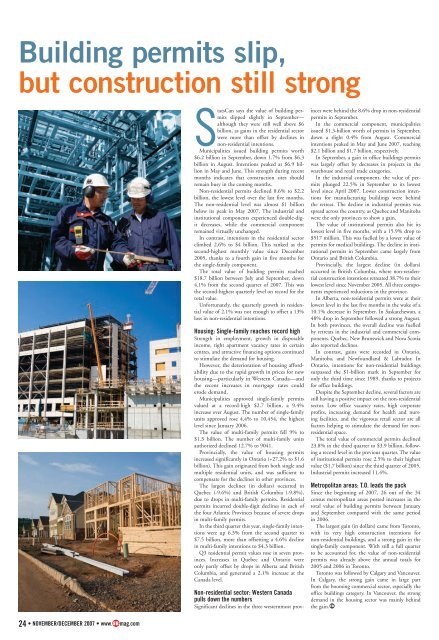Building permits slip,but construction still strongStatsCan says the value of building permitsslipped slightly in September—although they were still well above $6billion, as gains in the residential sectorwere more than offset by declines innon-residential intentions.Municipalities issued building permits worth$6.2 billion in September, down 1.7% from $6.3billion in August. Intentions peaked at $6.9 billionin May and June. This strength during recentmonths indicates that construction sites shouldremain busy in the coming months.Non-residential permits declined 8.6% to $2.2billion, the lowest level over the last five months.The non-residential level was almost $1 billionbelow its peak in May 2007. The industrial andinstitutional components experienced double-digitdecreases, while the commercial componentremained virtually unchanged.In contrast, intentions in the residential sectorclimbed 2.6% to $4 billion. This ranked as thesecond-highest monthly value since December2005, thanks to a fourth gain in five months forthe single-family component.The total value of building permits reached$18.7 billion between July and September, down4.1% from the second quarter of 2007. This wasthe second-highest quarterly level on record for thetotal value.Unfortunately, the quarterly growth in residentialvalue of 2.1% was not enough to offset a 13%loss in non-residential intentions.Housing: Single-family reaches record highStrength in employment, growth in disposableincome, tight apartment vacancy rates in certaincentres, and attractive financing options continuedto stimulate the demand for housing.However, the deterioration of housing affordabilitydue to the rapid growth in prices for newhousing—particularly in Western Canada—andthe recent increases in mortgage rates coulderode demand.Municipalities approved single-family permitsvalued at a record-high $2.7 billion, a 9.4%increase over August. The number of single-familyunits approved rose 4.4% to 10,454, the highestlevel since January 2006.The value of multi-family permits fell 9% to$1.3 billion. The number of multi-family unitsauthorized declined 12.7% to 9041.Provincially, the value of housing permitsincreased significantly in Ontario (+<strong>27</strong>.2% to $1.6billion). This gain originated from both single andmultiple residential units, and was sufficient tocompensate for the declines in other provinces.The largest declines (in dollars) occurred inQuebec (-9.6%) and British Columbia (-9.8%),due to drops in multi-family permits. Residentialpermits incurred double-digit declines in each ofthe four Atlantic Provinces because of severe dropsin multi-family permits.In the third quarter this year, single-family intentionswere up 6.3% from the second quarter to$7.5 billion, more than offsetting a 4.6% declinein multi-family intentions to $4.3 billion.Q3 residential permit values rose in seven provinces.Increases in Quebec and Ontario wereonly partly offset by drops in Alberta and BritishColumbia, and generated a 2.1% increase at theCanada level.Non-residential sector: Western Canadapulls down the numbersSignificant declines in the three westernmost provinceswere behind the 8.6% drop in non-residentialpermits in September.In the commercial component, municipalitiesissued $1.3-billion worth of permits in September,down a slight 0.4% from August. Commercialintentions peaked in May and June 2007, reaching$2.1 billion and $1.7 billion, respectively.In September, a gain in office buildings permitswas largely offset by decreases in projects in thewarehouse and retail trade categories.In the industrial component, the value of permitsplunged 22.5% in September to its lowestlevel since April 2007. Lower construction intentionsfor manufacturing buildings were behindthe retreat. The decline in industrial permits wasspread across the country, as Quebec and Manitobawere the only provinces to show a gain.The value of institutional permits also hit itslowest level in five months, with a 15.9% drop to$5<strong>17</strong> million. This was fuelled by a lower value ofpermits for medical buildings. The decline in institutionalpermits in September came largely fromOntario and British Columbia.Provincially, the largest decline (in dollars)occurred in British Columbia, where non-residentialconstruction intentions retreated 38.7% to theirlowest level since November 2005. All three componentsexperienced reductions in the province.In Alberta, non-residential permits were at theirlowest level in the last five months in the wake of a10.1% decrease in September. In Saskatchewan, a48% drop in September followed a strong August.In both provinces, the overall decline was fuelledby retreats in the industrial and commercial components.Quebec, New Brunswick and Nova Scotiaalso reported declines.In contrast, gains were recorded in Ontario,Manitoba, and Newfoundland & Labrador. InOntario, intentions for non-residential buildingssurpassed the $1-billion mark in September foronly the third time since 1989, thanks to projectsfor office buildings.Despite the September decline, several factors arestill having a positive impact on the non-residentialsector. Low office vacancy rates, high corporateprofits, increasing demand for health and nursingfacilities, and the vigorous retail sector are allfactors helping to stimulate the demand for nonresidentialspace.The total value of commercial permits declined23.8% in the third quarter to $3.9 billion, followinga record level in the previous quarter. The valueof institutional permits rose 2.5% to their highestvalue ($1.7 billion) since the third quarter of 2005.Industrial permits increased 11.4%.Metropolitan areas: T.O. leads the packSince the beginning of 2007, 26 out of the 34census metropolitan areas posted increases in thetotal value of building permits between Januaryand September compared with the same periodin 2006.The largest gain (in dollars) came from Toronto,with its very high construction intentions fornon-residential buildings, and a strong gain in thesingle-family component. With still a full quarterto be accounted for, the value of non-residentialpermits was already above the annual totals for2005 and 2006 in Toronto.Toronto was followed by Calgary and Vancouver.In Calgary, the strong gain came in large partfrom the booming commercial sector, especially theoffice buildings category. In Vancouver, the strongdemand in the housing sector was mainly behindthe gain.24 • november/december 2007 • www. mag.com
NEWSECTIONCOUNTER INTELLIGENCEDesigning an effective trainingprogram for your associatesBy Joe Hajek“Is training making a difference to our bottom line?”This question is increasingly being asked of HR andtraining departments across many companies. And it’sdifficult to answer when the company’s approach totraining employees focuses on responding to events as theyoccur, such as adding a new product line or new businessprocess, or discovering missing skills necessary for a job. Toooften, the results from this approach measure mastery of thetopic rather than impact on the bottom line.The question becomes easier to answer when, instead,training is viewed strategically: “What skills and knowledgedo employees need to accomplish their jobs, and how doestheir performance drive overall company performance?” Aneffective way to answer this question is with a competencybasedlearning program. It defines the competence requirementsfor job performance, the training that can develop thatcompetence, and ties in with organizational performance.According to David Dubois’ “Competency-BasedPerformance Improvement: A Strategy for OrganizationalChange”, a competency is a skill, trait, behaviour, attitude orbody of knowledge required to perform a job. For someonein sales, competencies might include:• being able to accurately fill out a sales order;• being able to listen by focusing on a customer’s voice, askingquestions and confirming his request; and,• being knowledgeable about products carried.These may be satisfactory for job performance. Exemplaryperformance competencies are important as well. Showing acontractor how a new tool can save time and money can bemore valuable than simply showing the features of the tool.The more specifically defined the competency, the easier itis to develop training for it, and the more effective the learningwill be. For example, “Excellent customer service andcommunication skills” as a competency is simply too broad,too general. It is made up of many behaviours, attitudes andtraits. Targeting training to specific behaviours, attitudes andtraits enables tangible changes in performance that will leadto improved customer service and communication.To determine how important these competencies are to acompany’s overall success requires a look at business goals.The first step in developing a competency-based learningprogram is to understand the company’s strategic businessgoals and the initiatives for achieving them. From that, theimpact of training on these goals can be determined.<strong>Business</strong> goals define competenciesTwo important goals for electrical distributors are profitablegrowth and providing a positive experience for customers.Initiatives to achieve these goals might include providingpricing and service valued by customers, managing profitabilityin sales, order processing efficiency and managinginventory levels effectively—all of which require contributionsfrom all parts of the company. Training can have animpact on many of the competencies required for thesecontributions, so it is important to include them in thetraining plan.All companies have three great resources for understandingthe skills, behaviours and attitudes that are necessaryto produce job outputs at desired performance levels: 1)employees, 2) job descriptions and, 3) performance evaluationcriteria.• Employees know how jobs are truly performed.• Job descriptions contain responsibilities (outputs) andqualifications (prerequisite competencies).• Performance criteria provide the measurementof performance.Input from these three sources provides the necessaryrequirements for desired competencies. For HR and trainingstaff, it is essential to involve managers and executivesin competency definition. They can best articulate companygoals and how employees contribute. It is also an excellentway to show them the value of training their direct reports,linking job performance with organizational performance.Competencies should integrate across different job roles.Vertical integration supports career planning and leadershipsuccession, providing an intentional plan for employeegrowth into more senior roles in the organization.Horizontal integration provides for consistent mastery ofcompetencies or knowledge across multiple roles at thesame level in the organization, such as key company valuesor core leadership skills.Foremost in determining specific training activities is toconsider delivery methods that effectively produce the learningoutcomes required to develop the desired competency.Training adults is most effective when it is interactive. Tasksand behaviours relevant to jobs can be practised beforeemployees try it on the job. Other factors to consider indeveloping training offerings are:• Delivery methods that incorporate multiplelearning styles.• Space and resources that are sufficient to reach employeeswho may be scattered among several branch locations.• Core company values reflected in the subject matter.• Company culture that is supportive of employees practisingwhat they have learned on the job.Cost constraints are always present, so it is important toprioritize the defined competencies to maximize the investmentin training. Those competencies that are more criticalto business success, or that impact a broad audience, arelikely to receive a larger investment. Specific training oftenoverlaps multiple competencies, which helps maximize thetraining investment.The result of this effort becomes a list of training activitiesthat map out specific competencies. The curriculum/competencymap shows employees what is necessary to performNeed some helpgetting started?<strong>Electrical</strong> distributors can turn tothe National Association of <strong>Electrical</strong>Distributors (NAED) for help. With thehelp of industry professionals, NAED’sEducation and Research Foundationhas created—and is validating—draftcompetencies for several distributorjob roles that can serve as a guide forcompanies designing their own trainingprograms. Publication of these drafts isplanned for the fall of 2008.Visit www.naed.orgsuccessfully in their jobs and how to develop their skills forimproved performance, career advancement and transition.For managers, it can show where training can impact organizationalperformance, making it easier to plan for employeetraining and address individual performance issues.Continued evaluation of the training program is essentialto ensure that learning outcomes provide the desired competencies,and development leads to improved employeeperformance. Ongoing review of the competency definitionsis also necessary so the organization can adapt to changingbusiness climates, which can change business goals. Newroles may be added or existing roles redefined, so competencieswill change.Developing a competency-based learning program is a bigeffort, but the payoff is even bigger. It is an effective way tomake sure employee training is focused where it should be,moving the company toward its goals and making a positivedifference to the bottom line.Joe Hajek is an instructional designer with the National Associationof <strong>Electrical</strong> Distributors (NAED), the association for the $70+ billionelectrical distribution channel. Joe fashioned this article aftera presentation he delivered at NAED’s HR & Training Conferencein October.Proudly Supporting OurDistributor Partnerswww.sylvania.comwww. mag.com • NOVEMBER/DECEMBER 2007 • 25
















